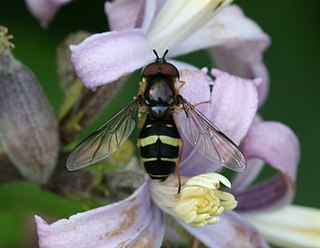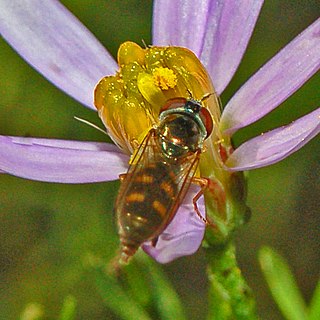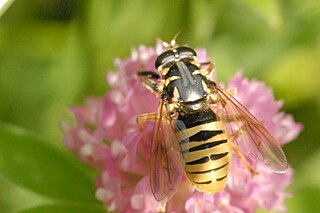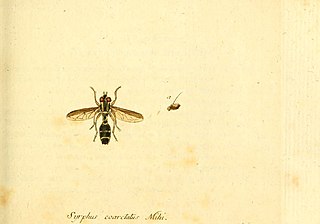
Hover flies, also called flower flies or syrphid flies, make up the insect family Syrphidae. As their common name suggests, they are often seen hovering or nectaring at flowers; the adults of many species feed mainly on nectar and pollen, while the larvae (maggots) eat a wide range of foods. In some species, the larvae are saprotrophs, eating decaying plant and animal matter in the soil or in ponds and streams. In other species, the larvae are insectivores and prey on aphids, thrips, and other plant-sucking insects.

Eristalinae are one of the four subfamilies of the fly family Syrphidae, or hoverflies. A well-known species included in this subfamily is the dronefly, Eristalis tenax.

Xylota segnis, The Brown-toed Forest Fly, is a common species of hoverfly.

Leucozona glaucia, the Pale-saddled Leucozona is a Palearctic hoverfly. Larvae feed on ground layer aphids. Adults are usually seen visiting flowers.

Platycheirus clypeatus is a species of hoverfly. It is found across the Palearctic and in the Nearctic. The larvae feed on aphids. Adults are usually found on the edges of woodland or scrub, heath or along hedgerows where they visit a wide range of flowers.

Eupeodes corollae is a very common European species of hoverfly. Adults are 6–11 millimetres (0.24–0.43 in) in body length. Males and females have different marking on the abdomen; males have square commas on tergites 3 and 4, whereas females have narrow commas. Larvae feed on aphids. This species has been used experimentally in glasshouses as a method of aphid control, and to control scale insects and aphids in fruit plantations. They were found to be partial to the fruit, eating more fruit than aphids.

Eupeodes luniger is a common species of hoverfly.

Merodon equestris is a Holarctic species of hoverfly. Like many other hoverflies it displays a colouration pattern similar to a stinging insect as an evolutionary defense mechanism. Other syrphid bee mimics are Mallota, Arctophila, Criorhina, Pocota and Brachypalpus. Merodon species are distinguished from these by the very strong hind femora, which bear a large triangular projection on the underside near the tip. It flies in low vegetation while the other bumblebee mimics prefer higher vegetation layers.

Dasysyrphus tricinctus is a European species of hoverfly in the genus Dasysyrphus, a member of the family Syrphidae. It is found across Europe, although reported in highest density from the British Isles and Scandinavia. While not uncommon it is generally only seen in modest numbers, typically in lowland woods with peak numbers in late May and early June and again in late August and early September.

Platycheirus peltatus is a Palearctic species of hoverfly.

Leucozona laternaria is a European species of hoverfly.

Leucozona lucorum is a Palearctic and Nearctic species of hoverfly.

Platycheirus scutatus is a very common species of hoverfly. It is a Holarctic species.

These are small black and yellow or mostly black flies with a narrow abdomen near the thorax. They occur mainly in damp places among low herbage. The larva of Neosascia are flattened without oral hooks and a have a short posterior spiracular process or "tail" rat-tailed that is saprophagous. In 1925 Curran reviewed the genus Neoascia. In this work a key is provided and ten species are described including four new species some of which have later been determined to be synonyms.

Pipiza is a genus Hoverflies, from the family Syrphidae, in the order Diptera. Most are dark hoverflies.

Temnostoma vespiforme is a species of hoverfly. Larva of this species feed in decaying wood of deciduous trees.

Syrphus torvus, the Hairy-eyed Flower Fly, is a common species of hoverfly found in the Holarctic. The adults feed on pollen and nectar, but the larvae feed on aphids.

Platycheirus ambiguus is a small widespread species of hoverfly found across the Palearctic from Ireland to Japan. A spring species found in flight in April and May, it visits spring-flowering trees and shrubs; e.g., Prunus spinosa in deciduous woodland and scrub.

Doros profuges is a Palearctic species of hoverfly.

The Spheginina is a subtribe of hoverflies.



















